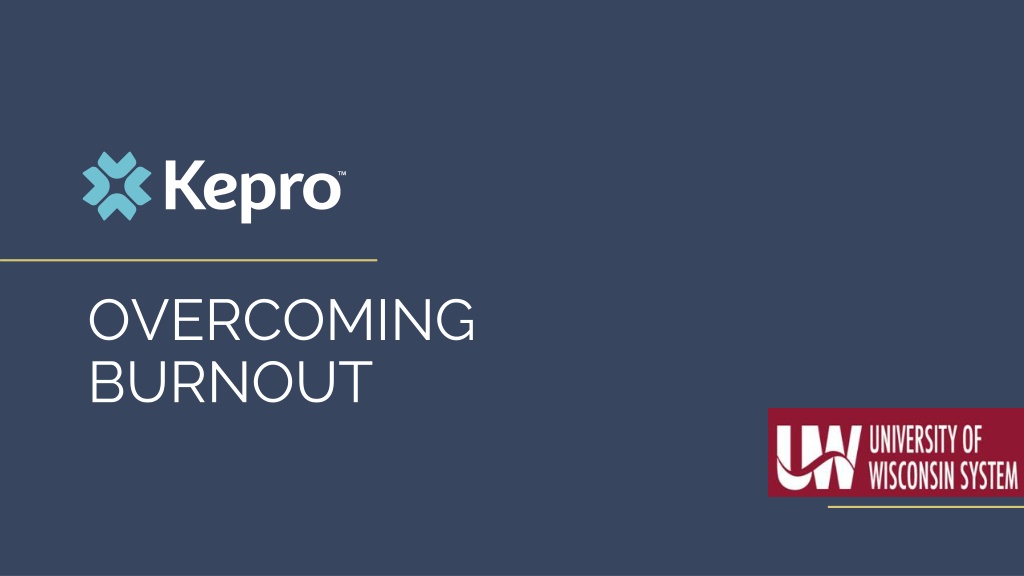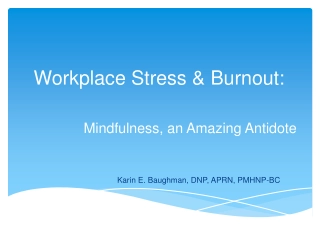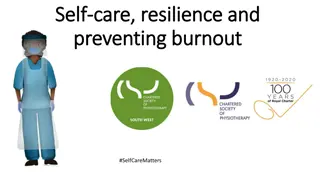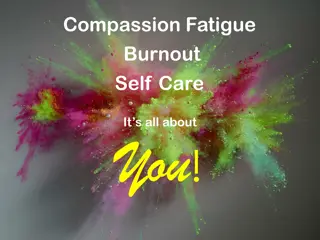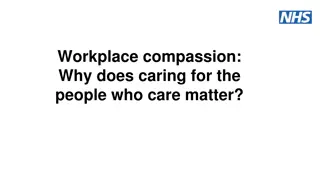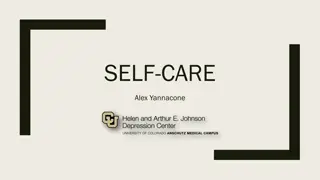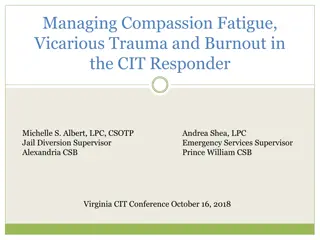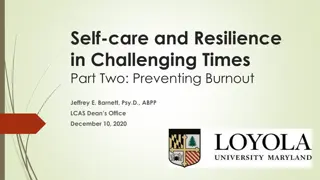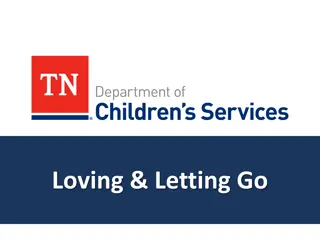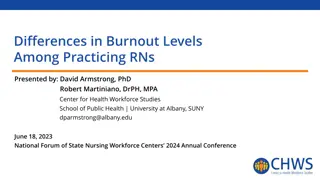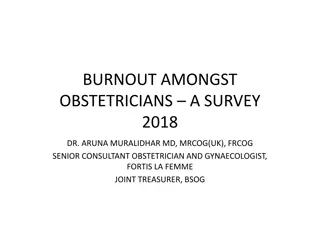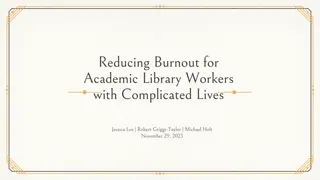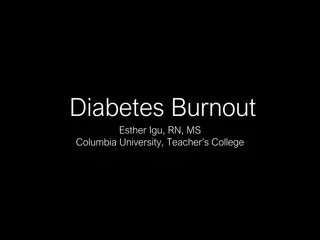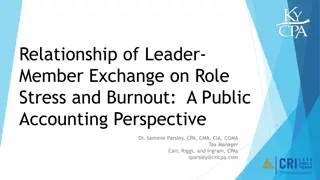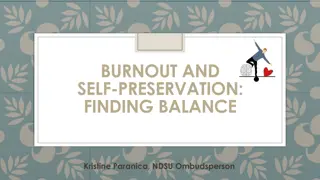Understanding and Overcoming Burnout in the Workplace
Learn how to recognize and address burnout to improve your mental well-being. Explore the causes, consequences, and strategies to overcome burnout, along with ways to help others facing similar challenges.
Download Presentation

Please find below an Image/Link to download the presentation.
The content on the website is provided AS IS for your information and personal use only. It may not be sold, licensed, or shared on other websites without obtaining consent from the author. Download presentation by click this link. If you encounter any issues during the download, it is possible that the publisher has removed the file from their server.
E N D
Presentation Transcript
OVERCOMING BURNOUT
Objectives Definition of burnout Recognize how burned out you are How to recognize burnout in others Consequences of burnout Basic self-care Strategies to overcome burnout Strategies to help others overcome burnout
The Facts Employees who say they very often or always experience burnout at work are: 63% more likely to take a sick day Half as likely to discuss how to approach performance goals with their manager 23% more likely to visit the emergency room 2.6 times as likely to leave their current employer 13% less confident in their performance Gallup Poll
What are the Causes? Lifestyle choices Lack of control Unclear or unrealistic expectations Job or workplace issues and concerns Individual personality characteristics
Burnout: What It Is vs. What It Is Not What Burnout is What Burnout is Not A condition related to: Regular mental or physical exhaustion Overwhelming stress Something a good night s sleep will fix Depletion of energy Inability to find inner strength Requires an action plan to recover
What Applies to Your Life? Dread going to work Crying, feeling anxious Low work morale Job security concerns Difficult co-workers Fewer staff/employees & more work Frequent distractions/upset Indecisive, insecure High pressure work environment Inability to say no Bitter about duties above your paygrade Last-minute project requests Lack of control over work or pace Feeling like a failure
What Applies to Your Life? Lack of information Meddling, overbearing bosses Monotonous work Underappreciated Speed/complexity of the workload Tight deadlines Too many demands Negative thinking Perfectionism Unclear job expectations Work in the helping profession Physical illness: gastrointestinal, ulcers, high blood pressure, heart attack, stroke Excessive self-medicating: eating, smoking, drinking, drugs
Assessing Your Level of Burnout How hard is it to get up in the a.m.? How much physical and emotional energy do you have on a scale of 1-10? How much do you enjoy your job on a scale of 1-10? How often do you feel excited at work on a scale of 1-10? Do you have 1 year, 3 year and 5 year plans? Do you still have dreams, hopes and aspirations for your job and career? The first step is awareness!!
Recognizing Burnout in Others Simply ask these same questions of your loved ones or co-workers Or, do you observe these behaviors in them? Burnout can be contagious Do you have co-workers who are ALWAYS negative and drag everyone down? What happens when work negativity spills over at home?
Components of Burnout Depersonalization: Separating yourself emotionally from your work; Disconnecting from work Decreased sense of accomplishment from work, resulting in a cycle of working more hours with no achievement or fulfillment Emotional exhaustion
Burnout Scale Cranky Tired Exhausted Depleted Burned Out
Consequences of Burnout Physical Psychological Occupational Chronic stress Depression Job dissatisfaction Fatigue Anxiety Withdrawal from colleagues High blood pressure Anger Poor work performance i.e. absenteeism, missing deadlines, negativity Increased risk for heart disease and diabetes Irritability Lack of motivation Turned down for potential growth opportunities Compromised immunity Feelings of helplessness Resentment
Complete the Stress Response Cycle Understand the difference between your stress triggers and stress Deal with the stress in your body, from a physiological perspective: Move Do something creative Laugh / Cry Take a deep breath Develop a support network of caring, compassionate, and encouraging people
Strategies to Prevent and Overcome Burnout Identify and address the root cause; keep asking why, until you find it Challenge yourself: fully use your potential Pace yourself Welcome change! Shake it up: change your commute, what you wear, or where you eat lunch. We need to change up the scenery from time to time! o Work on your organization skills and use a calendar Evaluate your progress and difficulties If you are truly burned out, find a mentor, coach, or counselor who can support and encourage you
Strategies to Prevent and Overcome Burnout Prevention Overcoming Self-care Identify the cause by performing a work analysis Exercise Diet Sleep o Communicate with your boss; areas of concern and potential solutions o o Draw support from others Work with purpose Find meaning in your work Set boundaries Reestablish balance between your work and personal life Communication Stress management skills
Basic Self-Care 3 Universal Core Needs: Sleeping, Eating And Moving Sleeping 7-9 hours seven nights a week for adults (children require 11-12) o Regulates mood, clears waste from our brain, and reenergizes our cells Eating Nutrition impacts your mood and energy o Intuitive eating - beware of eating as coping mechanism stress eating o Try eating lighter, healthier foods to increase your energy level, and eating smaller more frequent meals o Hydration 8 glasses of water each day (or half your body weight in ounces) Moving Helps your body and mind to recalibrate o Suggested 30 minutes per day or 3 smaller, 10 minute bursts of exercise. o Even 5 minutes of outdoor exercise can have a meaningful psychological impact o Exercise reduces sensitivity to anxiety (a key symptom of burnout) o o o
Encourage Others to Live a Healthy Lifestyle Support trial and errors on their part, as long as they are trying Manipulate changes Push others to go out of their comfort zone Concentrate on what you can control. Let go of what you can t control Acknowledge that you understand burnout while encouraging them to set goals
Reversing Burnout: Techniques Expect life to be challenging from time to time Manage expectations: control what you can control Focus on the positives in your life Recognize that burnout is reversible Learn from your mistakes: fix em and forget em Clearly define roles and responsibilities at work and at home Improve communication Learn effective time management: schedule and delegate Talk to your doctor about your concerns and any physical or emotional symptoms
Reversing Burnout: Techniques (continued) Practice relaxation techniques: mindfulness, guided meditation Take breaks Say no Celebrate accomplishments Reframe the experience; change the way you look at your job Connect with peers who will encourage you to be more positive Leave work on time Take breaks: lunch, vacations Start the day with music that pumps you up Put yourself first: make time for self-care
EAP Services available to employees, any household members and dependents Your Kepro EAPur Kepro EAP Confidential EAP Counselors available 24/7/365 via 833-539-7285 Up to 6 in person counseling sessions, per issue, per year Management Consultations Financial/Legal Consultation and Referral Service Work/Life & Convenience Services https://sowi.mylifeexpert.com Company code: SOWI
We want to hear your feedback! Please complete a training evaluation. Thank you! https://app.smartsheet.com/b/form/dacb2d9b38564db4afb5ab8426d91ad6
Questions & Answer Overcoming Burnout
